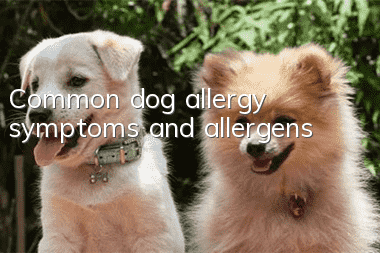Common dog allergy symptoms and allergens

As people pay more and more attention to pets, many problems that have not been paid attention to before have gradually come into people's sight, such as: "allergy".
It has nothing to do with the quality of the food. Allergies come from the reaction of the organism itself. Therefore, no matter how good the raw materials are and how expensive the dog food is, it cannot solve the problem of dog allergies. The only way to determine the allergic ingredients according to the dog’s symptoms and constitution is to avoid eating allergens. can solve this problem.
Allergy symptoms
Food allergies occur when a dog's immune system mistakenly believes that a certain food ingredient (usually a protein source) is harmful. The dog's immune system produces defensive antibodies to fight against invading enemies (components). When this defense exceeds the normal range, the immune system may even damage normal body tissues, which is very detrimental to the dog's health.
Common food allergy symptoms include:
Itchy skin
Sneezing
Itchy paws
skin infections resulting from excessive scratching, also known as Hot spots
Skin rashes
Scaly and/or oily skin
Pigmented skin
Leathery skin texture
Eye discharge
Red eyes
Vomiting and diarrhea
Hair loss
Ear infections
When a pet owner asks a pet store: "Are allergies hereditary?" You need to tell him: "Yes." Allergies usually come from genetic inheritance.
7 Common Dog Allergy Foods
Although different individuals will be allergic to different foods, for different species, the categories that are likely to cause allergies are traceable. For dogs, common allergic foodsThere are 7 types of raw materials.
Beef. Beef is a common ingredient in many pet foods and a possible cause of allergies in dogs.
Dairy products. Some dogs have difficulty digesting lactose and may be lactose intolerant rather than allergic. Lactose intolerance can cause gas, diarrhea, or vomiting. If you are allergic to dairy products, you will also have such symptoms. The only difference is that dairy allergy may affect the skin and cause symptoms such as itching, while intolerance is only related to the digestive system.
Wheat. There are many misconceptions about carbohydrate-containing foods for dogs, especially grains. For example, allergies to meat are more common in dogs than allergies to grains. However, some dogs do have allergic reactions to wheat.
Eggs. Egg allergy is mainly due to the protein content in egg yolks. There are not many dog foods with egg ingredients. As long as you read the label carefully, you can avoid it.
Chicken. Even though this is a common source of protein, that doesn’t mean dogs won’t be allergic to it.
Mutton. Since many dog foods are made from chicken and beef, to prevent allergies, many people choose dog foods whose main ingredient is mutton. However, lamb can also be an allergen. Therefore, if your dog is unfortunately allergic to beef, chicken, and mutton, you can recommend that your client try venison.
Soy. Eating soy may indeed cause allergies, and studies have shown that in addition to allergies, it can also cause other health problems, such as reproductive and development problems, thyroid disease, and liver disease. Therefore, you must pay attention to dog food containing soy ingredients. its content.
Dog breeds prone to allergies
Although there is currently no scientific indication as to which dog breeds are more likely to develop allergies, relevant media based on search engine search records have summarized the “most commonly searched dog breeds for pet owners”. Although they are subject to “popular dog breeds” "The owner's mentality" and other factors are affected, but this can also be used as a reference for "dog breeds prone to allergies".
Dachshunds
Bulldogs
Golden Retrievers
German Shepherdrds)
Pugs
Pitbulls
Cocker Spaniels
Shih Tzus
West Highland White Terrier(Westies)
Yorkshire Terrier(Yorkies)
How to determine allergens
If your dog has allergic symptoms, some allergen testing may be required. It is worth noting that the results of the allergen test can only be used as a reference.
Store owners can teach your customers a simple way to identify allergens:
Stop eating all the food raw materials that the dog currently eats, and instead feed food with other raw materials, such as uncommon: venison, sweet potatoes, etc. After the allergic reaction completely disappears, gradually add the previous raw materials (each raw material added A few days apart), if an allergic reaction occurs, we can basically identify the culprit.
Once the allergen is identified, try to avoid it as much as possible during subsequent feedings.
- What should you do if your dog is aggressive? What are the causes of aggressive dog behavior and how to correct it!
- What's going on when a puppy vomits?
- What should I do if my dog loses a lot of hair in summer?
- How should you feed your dog? Teach you how to feed your dog food correctly and scientifically
- How to train a dog to sleep in his own kennel? Train your dog to get used to sleeping in the kennel!
- The puppy can’t bark, it can only grunt.
- When should dogs be vaccinated?
- How to treat diarrhea in puppies? How to treat diarrhea in dogs!
- Symptoms and treatments for patellar translocation in dogs
- Treatment of anal adenitis in dogs



